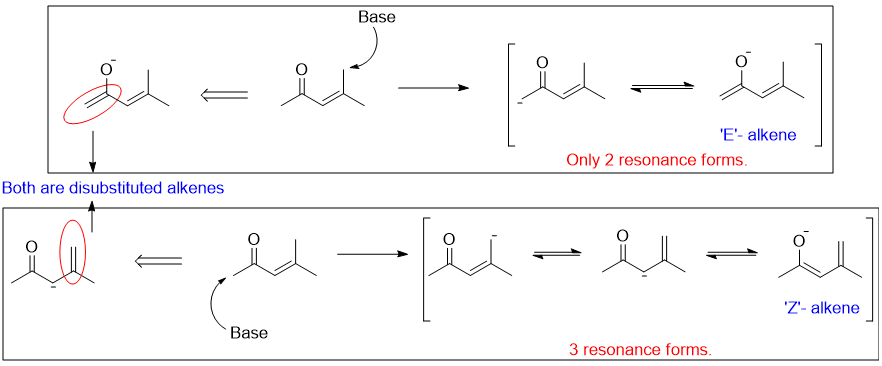A few comments are in order as to the way in which the enolate formation is conducted. Lithium diisopropylamide (LDA) is formed in situ from the free amine and n-BuLi at -78oC at which temperature the ketone, in this case mesityl oxide, is added slowly as the minimal reactant (excess LDA). Subsequent addition of trimethylsilyl chloride produces the enol silyl ether. This mode of addition minimizes enolate exchange (α $\rightarrow$ γ). Excess ketone runs the risk of proton exchange with formation of the thermodynamic enolate.
Question 1:
Why does deprotonation occur from the alpha carbon on the left, and not from the gamma carbon? Is it due to steric repulsion between lone pair of oxygen and negative charge on Nitrogen? But there two gamma carbons, and only one would be hindered?
While the electron pairs on oxygen and LDA are bases, the lithium cation can coordinate with the oxygen just as it does with the solvent tetrahydrofuran (THF). Incidently, the rate of the deprotonation of 2,2,6-trimethylcyclohexanone has been shown1 to be first order in ketone and one-half order in LDA.
Question 2:
The condition shown is the kinetic condition (LDA,THF, -78 °C). So the given enolate is the kinetic enolate. Is it classified as a kinetic enolate due to the lesser number of resonance structures (less stable alkene)?
(Normally, if the enolate is less substituted, it is termed as kinetic, and more substituted one is the thermodynamic enolate).
The less substituted enolate is the kinetic one but not because the $\ce{C1}$ methyl is less substituted. Kinetic has to with the rate of formation. Both the kinetic and thermodynamic enolates have single resonance structures but two canonical ones in the former case and three in the latter.
Question 3:
Should the carbanion stability of each resonance hybrid be accounted to determine the type of enolate?
In a sense, yes. The γ-enolate (thermodynamic) has greater delocalization of the negative charge than does the α-enolate (kinetic).
Why is the methyl group deprotonated kinetically? Comparison of the liquid film infrared carbonyl of the α,β-unsaturated ketones 1-3 provides a clue.3 The smaller the carbonyl stretching frequency the more single bond character in the carbonyl group. The enone moiety in cyclohexenone 3 has strong conjugation between the carbonyl and the double bond owing to restricted rotation about the $\ce{C1-C2}$ bond. The methylene group is deprotonated kinetically.2 Enones 1 and 2 have a degree of free rotation about their respective $\ce{C2-C3}$ bonds. Steric interactions between $\ce{C6}$ and the carbonyl oxygen or $\ce{C1}$ causes mesityl oxide 1 to have a higher frequency than pentenone 2, which is missing the $\ce{C6}$ methyl. Thus, in 1 and 2, the γ C-H bonds are out of conjugation to a greater extent than the methyl α C-H bonds, which are always available for overlap with the carbonyl group.

- M. Majewski and P. Nowak, Tetrahedron Letters, 1998, 39, 1661.
- W. D. Shipe and E. J. Sorensen, Organic Letters, 2002, 4, 2063.
- SDBS DataBase of Organic Compounds




